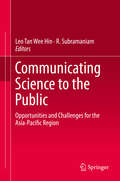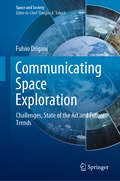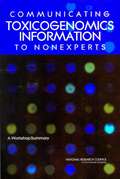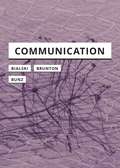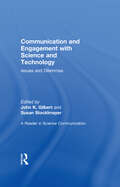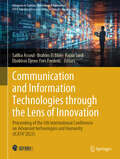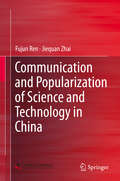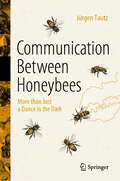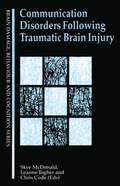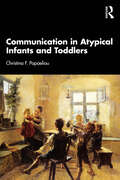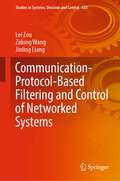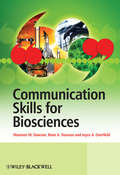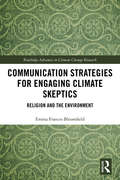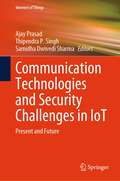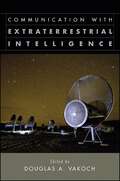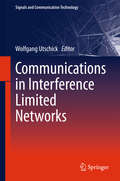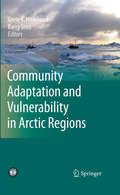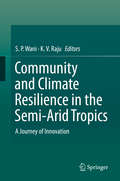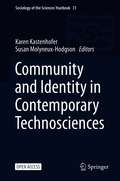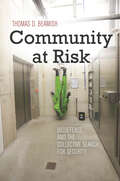- Table View
- List View
Communicating Science to the Public: Opportunities and Challenges for the Asia-Pacific Region
by Leo Tan Wee Hin R. SubramaniamThis book explores effective approaches for communicating science to the public in developing countries. Offering multiple perspectives on this important topic, it features 17 chapters that represent the efforts of 23 authors from eight countries: Australia, Bangladesh, India, Ireland, New Zealand, USA, Singapore and South Africa. Inside, readers will find a diversity of approaches to communicate science to the public. The book also highlights some of the challenges that science communicators, science policy makers, science teachers, university academics in the sciences and even entrepreneurs may face in their attempts to boost science literacy levels in their countries. In addition, it shares several best practices from the developed world that may help readers create communication initiatives that can lead to increased engagement with science in communities in the Asia Pacific region and beyond. Given the pervasive influence of science and technology in today's society, their impact will only increase in the years to come as the world becomes more globalized and the economies of countries become more inter-linked. This book will be a useful source of reference for developing countries looking to tap into the potential of science for nation building and effectively engage their communities to better understand science and technology. Supported by the Pacific Science Association, Hawaii.
Communicating Space Exploration: Challenges, State of the Art and Future Trends (Space and Society)
by Fulvio DriganiThis book offers an enlightening analysis of the ways in which the communication of space explorations has evolved in response to political and social developments and the availability of new media and communication tools. Important challenges to effective communication are discussed, including the diversity of audiences, the risks associated with space missions, and continuing skepticism about the benefits of space research despite the many associated day-to-day applications. In addition, future trends in communication are examined with reference to likely trends in space exploration over the coming century. Besides space communication for the public, the need for targeted messaging to each group of stakeholders – decision makers, media, opinion leaders, the scientific community, and industry – is analyzed in detail. A series of case studies of particular space missions, both successful and unsuccessful, is presented to illustrate key issues. The book has significant implications for the communication of science in general and will be of interest to a wide audience, including space scientists, science communication professionals, people fascinated by exploration and discovery, stakeholders, and educators.
COMMUNICATING TOXICOGENOMICS INFORMATION TO NONEXPERTS: A Workshop Summary
by National Research Council of the National AcademiesThe National Academies Press (NAP)--publisher for the National Academies--publishes more than 200 books a year offering the most authoritative views, definitive information, and groundbreaking recommendations on a wide range of topics in science, engineering, and health. Our books are unique in that they are authored by the nation's leading experts in every scientific field.
Communicating With Data: The Art Of Writing For Data Science
by Deborah Nolan Sara StoudtCommunication is a critical yet often overlooked part of data science. Communicating with Data aims to help students and researchers write about their insights in a way that is both compelling and faithful to the data. General advice on science writing is also provided, including how to distill findings into a story and organize and revise the story, and how to write clearly, concisely, and precisely. This is an excellent resource for students who want to learn how to write about scientific findings, and for instructors who are teaching a science course in communication or a course with a writing component.
Communication: Essays On Communication, Materiality, And Society (In Search of Media)
by Paula Bialski Finn Brunton Mercedes BunzOn contemporary communication in its various human and nonhuman formsContemporary communication puts us not only in conversation with one another but also with our machinery. Machine communication—to communicate not just via but also with machines—is therefore the focus of this volume. Diving into digital communications history, Finn Brunton brings to the fore the alienness of computational communication by looking at network timekeeping, automated trolling, and early attempts at communication with extraterrestrial life. Picking up this fascination with inhuman communication, Mercedes Bunz then performs a close reading of interaction design and interfaces to show how technology addresses humans (as very young children). Finally, Paula Bialski shares her findings from a field study of software development, analyzing the communicative forms that occur when code is written by separate people. Today, communication unfolds merely between two or more conscious entities but often includes an invisible third party. Inspired by this drastic shift, this volume uncovers new meanings of what it means &“to communicate.&”
Communication and Engagement with Science and Technology: Issues and Dilemmas - A Reader in Science Communication
by John K. Gilbert Susan StocklmayerScience communication seeks to engage individuals and groups with evidence-based information about the nature, outcomes, and social consequences of science and technology. This text provides an overview of this burgeoning field ─ the issues with which it deals, important influences that affect it, the challenges that it faces. It introduces readers to the research-based literature about science communication and shows how it relates to actual or potential practice. A "Further Exploration" section provides suggestions for activities that readers might do to explore the issues raised. Organized around five themes, each chapter addresses a different aspect of science communication: • Models of science communication – theory into practice • Challenges in communicating science • Major themes in science communication • Informal learning • Communication of contemporary issues in science and society Relevant for all those interested in and concerned about current issues and developments in science communication, this volume is an ideal text for courses and a must-have resource for faculty, students, and professionals in this field.
Communication and Information Technologies through the Lens of Innovation: Proceeding of the 5th International Conference on Advanced technologies and Humanity (ICATH'2023) (Advances in Science, Technology & Innovation)
by Saliha Assoul Brahim El Bhiri Rajaa Saidi Ebobisse Djene Yves FredericThis book is a comprehensive proceedings book that delves into cutting-edge research and insights in the field of communication and information technologies. Featuring a wide range of research papers and case studies, this book offers a deep exploration of the intersection between technology, innovation, and communication. From examining the impact of digital transformation on organizational change to investigating the role of smart education and intelligent learning systems, each chapter provides valuable insights into key topics shaping the landscape of communication and information technologies. The book offers case studies that highlight the implementation of digital platforms for legal information and the leveraging of e-services for enhanced importation and foreign investments. This book also delves into advancements in machine learning, including studies on imbalanced datasets and disease categorization. It explores the realm of edge computing systems with a focus on workflow scheduling and examines the impact of radiofrequency on biological systems. Readers will gain valuable insights into antenna design for various applications, satellite imagery analysis, virtual reality therapy for autism, and the simulation of dento-facial deformities through 3D virtual model simulation. With a focus on practical research and innovative solutions, this book serves as a valuable resource for researchers, practitioners, and industry professionals interested in the evolving landscape of technology-driven communication and information systems.
Communication and Popularization of Science and Technology in China
by Fujun Ren Jiequan ZhaiThis book aims to be a reference for researchers studying the promotion of scientific literacy in China, as well as a guide for those interested in promoting scientific awareness. It covers advances in science and technology, communication and popularization practice, and research (STCP) both in China and abroad. Theoretical issues are discussed, and important problems in promoting scientific and technological awareness are identified (e. g. : basic principles, structures, channels of communication and current needs) This bookprovides a summary of the advances in STCP in China in recent years (especially after the issuing of the "National Scientific Literacy Outline") including STCP resource and capacity building, science popularization policies, practitioner development, infrastructure construction, and the development of the science popularization industry as a whole. At the same time, this book also reviews thedesign, organization, monitoring and evaluation of science and technology communication and popularization programs. It also highlights current STCP trends and developments in China and calls for a greater emphasis to be placed on research into promoting scientific literacy. It is hoped that this book will be useful to readers both in China and abroad by familiarizing them with the history and theory of STCP as well as its development over time. The 1st chapter briefly reviews the history of STCP. The 2nd through 5th chapters discuss the conceptual framework, basic structure, methods of communication, and current STCP needs. The 6th chapter introduces the principle content of programs aimed at improving Chinese citizens' scientific literacy, while the 7th and 8th chapters analyze the resources, capacities and conditions that have been developed for STCP in China. The 9th chapter investigates the organization, monitoring and evaluation of science popularization practices, and the final chapter summarizes important STCP topics and trends in contemporary China.
Communication Between Honeybees: More than Just a Dance in the Dark
by Jürgen TautzJürgen Tautz, renowned German bee researcher explains how bees communicate. Exciting and surprising new insights on communication between bees. During the history of bee research, scientists have peered deep into the inner life of bee colonies and learned much about the behaviour of these insects. Above all, the bee waggle dance has become a famous and extensively discussed phenomenon. Nevertheless, recent insights reveal that while bees are social insects inside the hive they also communicate with one another outside the hive. In this book, Jürgen Tautz, renowned German bee researcher, provides an entertaining, fresh and enlightened account for lay and professional readers, not only about the fascinating dance language but also about additional remarkable phenomena concerning information exchange between bees. From the author of the bestseller “The Buzz about Bees”. “The Language of Bees” assembles, for the first time, a complete overview of how bees understand one another. Although communication biology research on bees has so far concentrated largely on events within the hive, this book directs attention as well, to how bees communicate in the field outside the hive. The reader learns which steps new bee recruits take to reach the feeder a dancing forager has advertised. The book analyses the status of work on the bee dance published over the last 100 years and orders the essential findings as building blocks into a coherent new concept of how bees find their target. In addition, the historical survey of research on the “Bee Language” explains how several contradictory and incomplete hypotheses can still survive. A fresh point of view on one of the most remarkable behavioural performances in the animal kingdom. Observation from a different viewpoint leads to previously unknown insights. Such new perspectives clearly reveal both how large the gaps in our knowledge still are in relation to the language of bees and in which direction research must take to complete the picture of one of the most impressive behavioural accomplishments in animals. Prof. Dr. Jürgen Tautz is an expert on bees, sociobiologist, animal behaviourist and emeritus professor at the Biozentrum, University of Würzburg. He is a bestseller author and recipient of many awards of excellence for his successful communication of science to a wide public.
Communication, Culture and Ecology: Rethinking Sustainable Development in Asia (Communication, Culture and Change in Asia #6)
by Kiran PrasadThis book offers comprehensive insights into the cultural and ecological values that influence sustainable development across Asia, addressing the cultural, religious and philosophical moorings of development through participatory and grassroots communication approaches. It presents a range of contributions and case studies from leading experts in Asia to highlight the debates on environmental communication and sustainable development that are relevant today, and to provide an overview of the positive traditions of ecological sensitivity and cultural communication that may find common ground between communities. This well-researched guide to the dynamic and complex terrain of communication for sustainable development offers uniquely practical perspectives on communication, environment and sustainable development that are of immense value for policy makers, media scholars, development practitioners, researchers and students of communication and media studies.
Communication Disorders Following Traumatic Brain Injury: Management Of Cognitive, Language And Motor Impairments (Brain, Behaviour and Cognition)
by Leanne Togher Chris Code Skye McDonaldThere are very few books available which are concerned with the unique communication problems that can come with traumatic brain injury (TBI). In recent years there has emerged a realisation that these difficulties in communication are closely tied to the cognitive, behavioural and social problems observed following traumatic brain injury. This is changing the way people with TBI are assessed and is generating new approaches to rehabilitation.This volume will be of interest to psychologists, speech pathologists and therapists and linguists. Clinicians and researchers working with people with traumatic brain injury, and their students, will find it a comprehensive source of contemporary approaches to characterising the communication problems of people with TBI and for planning rehabilitation.
Communication in Atypical Infants and Toddlers
by Christina F. PapaeliouThis book presents a comparative review of the latest studies and data on prelinguistic communication and early semantic development in autism spectrum disorder (ASD), Williams syndrome (WMS), attention-deficit/hyperactivity disorder (ADHD), and early language delay. Papaeliou offers a critical analysis of the literature, compares key theoretical approaches, and interprets data on development in atypical populations.A fruitful synthesis of theory and research reveals that, instead of cognitive deficits, the core feature of these neurodevelopmental disorders consists of deficits in the ability for self- and intersubjective coordination, which adversely affects early interactions and, consequently, the emergence of language. The book composes fragmentary proposals on the role of rhythm disruptions in different conditions, setting out the idea that disruption in interactional synchrony is a connecting thread through neurodevelopmental disorders which show high prevalence or high comorbidity rates. Papaeliou identifies distinct communicative patterns characteristic of each disorder and puts forward a unifying theory for interpreting data on early communication and language development in atypical populations.This is ideal reading for psychologists, psycholinguists, psychiatrists, paediatricians, speech therapists, and special educators. Students in developmental psychology and anyone interested in understanding the research behind typical and atypical development will also benefit from this text.
Communication-Protocol-Based Filtering and Control of Networked Systems (Studies in Systems, Decision and Control #430)
by Lei Zou Zidong Wang Jinling LiangCommunication-Protocol-Based Filtering and Control of Networked Systems is a self-contained treatment of the state of the art in communication-protocol-based filtering and control; recent advances in networked systems; and the potential for application in sensor networks. This book provides new concepts, new models and new methodologies with practical significance in control engineering and signal processing. The book first establishes signal-transmission models subject to different communication protocols and then develops new filter design techniques based on those models and preset requirements for filtering performance. The authors then extend this work to finite-horizon H-infinity control, ultimately bounded control and finite-horizon consensus control. The focus throughout is on three typical communications protocols: the round-robin, random-access and try-once-and-discard protocols, and the systems studied are drawn from a variety of classes, among them nonlinear systems, time-delayed and time-varying systems, multi-agent systems and complex networks. Readers are shown the latest techniques—recursive linear matrix inequalities, backward recursive difference equations, stochastic analysis and mapping methods. The unified framework for communication-protocol-based filtering and control for different networked systems established in the book will be of interest to academic researchers and practicing engineers working with communications and other signal-processing systems. Senior undergraduate and graduate students looking to increase their knowledge of current methods in control and signal processing of networked systems will also find this book valuable.
Communication Skills for Biosciences
by Maureen Dawson Brian Dawson Joyce OverfieldThis text is comprehensive, user-friendly handbook that will guide students through the full range of written and spoken communication skills that are demanded by today's biosciences courses. The book also offers a valuable refresher for postgraduate students who wish to review or expand their proficiency in these areas. This book will provide the student with practical advice on how best to communicate scientific material to different audiences including their peers, their tutors and to non-scientists. Key Features: Highly accessible, confidence-building, student-friendly guide Provides comprehensive coverage of the complete range of presentation skills needed by students Covers essay writing, practical reports, dissertations, projects and presenting in individual, group and poster presentation settings Offers advice on how to avoid common errors including plagiarism using 'what not to do' boxes throughout the text Includes practical advice on how best to communicate scientific material to different audiences e.g. undergraduates, tutors and non-scientists
Communication Strategies for Engaging Climate Skeptics: Religion and the Environment (Routledge Advances in Climate Change Research)
by Emma Frances BloomfieldCommunication Strategies for Engaging Climate Skeptics examines the intersection of climate skepticism and Christianity and proposes strategies for engaging climate skeptics in productive conversations. Despite the scientifically established threats of climate change, there remains a segment of the American population that is skeptical of the scientific consensus on climate change and the urgent need for action. One of the most important stakeholders and conversants in environmental conversations is the religious community. While existing studies have discussed environmentalism as a factor within the religious community, this book positions religion as an important factor in environmentalism and focuses on how identities play a role in environmental conversation. Rather than thinking of religious skeptics as a single unified group, Emma Frances Bloomfield argues that it is essential to recognize there are different types of skeptics so that we can better tailor our communication strategies to engage with them on issues of the environment and climate change. To do so, this work breaks skeptics down into three main types: "separators," "bargainers," and "harmonizers." The book questions monolithic understandings of climate skepticism and considers how competing narratives such as religion, economics, and politics play a large role in climate communication. Considering recent political moves to remove climate change from official records and withdraw from international environmental agreements, it is imperative now more than ever to offer practical solutions to academics, practitioners, and the public to change the conversation. To address these concerns, this book provides both a theoretical examination of the rhetoric of religious climate skeptics and concrete strategies for engaging the religious community in conversations about the environment. This book will be of great interest to students, scholars, and practitioners of climate change science, environmental communication, environmental policy, and religion.
Communication Technologies and Security Challenges in IoT: Present and Future (Internet of Things)
by Ajay Prasad Thipendra P. Singh Samidha Dwivedi SharmaThis book presents overall communication technologies and protocols used in IoT like in networks: Wi-Fi, Bluetooth, Zigbee, LoRA, GSM/GPRS/EDGE/LTE, etc. in applications: MQTT, CoAP, AMQP, XMPP, etc, focusing on the architecture and threat perseverance of each. The book also presents new/future technological additions like Wi-Fi HaLow (802.11ah), HEW (802.11ax), BLE, NFC, RFID, etc.,) and upcoming changes in communication systems in IoT and its possible security aspects. The book also covers security aspects in communication mechanisms in domain-specific IoT solutions for healthcare, smart cities, smart homes, smart vehicles, etc. The objective of the book is to assist IoT developers to have a good insight into available and upcoming communication technologies so that they can employ the best possible practices while designing and developing IoT solutions.
Communication with Extraterrestrial Intelligence (CETI)
by Douglas A. VakochIn April 2010, fifty years to the month after the first experiment in the Search for Extraterrestrial Intelligence (SETI), scholars from a range of disciplines—including astronomy, mathematics, anthropology, history, and cognitive science—gathered at NASA's biennial Astrobiology Science Conference (AbSciCon) for a series of sessions on the search for intelligent life. This book highlights the most recent developments in SETI discussed at that conference, emphasizing the ways that SETI has grown since its inception. The volume covers three broad themes: First, leading researchers examine the latest developments in observational SETI programs, as well as innovative proposals for new search strategies and novel approaches to signal processing. Second, both proponents and opponents of "Active SETI" debate whether humankind should be transmitting intentional signals to other possible civilizations, rather than only listening. Third, constructive proposals for interstellar messages are juxtaposed with critiques that ask whether any meaningful exchange is possible with an independently evolved civilization, given the constraints of contact at interstellar distances, where a round-trip exchange could take centuries or millennia.As we reflect on a half-century of SETI research, we are reminded of the expansion of search programs made possible by technological and conceptual advances. In this spirit of ongoing exploration, the contributors to this book advocate a diverse range of approaches to make SETI increasingly more powerful and effective, as we embark on the next half-century of searching for intelligence beyond Earth.
Communications in Interference Limited Networks (Signals and Communication Technology)
by Wolfgang UtschickThis book offers means to handle interference as a central problem of operating wireless networks. It investigates centralized and decentralized methods to avoid and handle interference as well as approaches that resolve interference constructively. The latter type of approach tries to solve the joint detection and estimation problem of several data streams that share a common medium. In fact, an exciting insight into the operation of networks is that it may be beneficial, in terms of an overall throughput, to actively create and manage interference. Thus, when handled properly, "mixing" of data in networks becomes a useful tool of operation rather than the nuisance as which it has been treated traditionally. With the development of mobile, robust, ubiquitous, reliable and instantaneous communication being a driving and enabling factor of an information centric economy, the understanding, mitigation and exploitation of interference in networks must be seen as a centrally important task.
Communities of Learned Experience: Epistolary Medicine in the Renaissance (Singleton Center Books in Premodern Europe)
by Nancy G. SiraisiSixteenth-century physicians had their letters on medical topics published in printed collections to record their exchange of ideas and make known their professional expertise.During the Renaissance, collections of letters both satisfied humanist enthusiasm for ancient literary forms and provided the flexibility of a format appropriate to many types of inquiry. The printed collections of medical letters by Giovanni Manardo of Ferrara and other physicians in early sixteenth-century Europe may thus be regarded as products of medical humanism. The letters of mid- and late sixteenth-century Italian and German physicians examined in Communities of Learned Experience by Nancy G. Siraisi also illustrate practices associated with the concepts of the Republic of Letters: open and relatively informal communication among a learned community and a liberal exchange of information and ideas. Additionally, such published medical correspondence may often have served to provide mutual reinforcement of professional reputation. Siraisi uses some of these collections to compare approaches to sharing medical knowledge across broad regions of Europe and within a city, with the goal of illuminating geographic differences as well as diversity within social, urban, courtly, and academic environments. The collections she has selected include essays on general medical topics addressed to colleagues or disciples, some advice for individual patients (usually written at the request of the patient’s doctor), and a strong dose of controversy.
Community Action for Conservation: Mexican Experiences
by Luciana Porter-Bolland Isabel Ruiz-Mallén Claudia Camacho-Benavides Susannah R. MccandlessThis book provides an in-depth analysis on community conservation in Mexico. The volume explores vivid examples and case studies that illustrate some of the critical issues at stake, including the participation of local communities in national and global conservation, indigenous and local perceptions of conservation initiatives in Southern Mexico, and challenges in ICCA governance and ecotourism. The book also reviews methodological approaches for understanding and strengthening community conservation, touching upon such topics as community-based biodiversity monitoring and tools for understanding children's perceptions of community conservation. Written by international experts in the field, Community Action for Conservation: Mexican Experiences is a lively and deep-running resource that offers invaluable stories and analyses of the Mexican experience with conservation.
Community Adaptation and Vulnerability in Arctic Regions: Framework Document For An International Polar Year Consortium
by Barry Smit Grete K. HovelsrudUnder the auspices of International Polar Year (IPY), the CAVIAR consortium was formed with partners from all eight Arctic countries. The aim of the interdisciplinary CAVIAR project is to increase understanding of the vulnerability of Arctic communities to changing environmental conditions, including climate change, and to contribute to the development of adaptive strategies and policies. In partnership with local collaborators in over two dozen communities, researchers have documented the conditions and forces that contribute to vulnerabilities, identified adaptive strategies and attempted to assess the prospects for adaptation in the future.
Community and Climate Resilience in the Semi-Arid Tropics: A Journey of Innovation
by K. V. Raju S. P. WaniThis book focuses on developing an integrated holistic approach for harnessing the potential of rain-fed agriculture. In this approach, rainwater management through harvesting and recharging the groundwater is used as an entry point activity for increasing the productivity for farmers through enhanced water use efficiency. To provide the holistic and integrated solutions, the approach of consortium through building partnerships with different stakeholders, eg. different research institutions (State, National and International), development departments, eg. Department of Agriculture, Department of Animal Husbandry etc., Non-Government Organizations (NGOs), Farmers Organizations Community-based Organizations (CBOs) along with market linkages through private companies.
Community and Identity in Contemporary Technosciences (Sociology of the Sciences Yearbook #31)
by Karen Kastenhofer Susan Molyneux-HodgsonThis open access edited book provides new thinking on scientific identity formation. It thoroughly interrogates the concepts of community and identity, including both historical and contemporaneous analyses of several scientific fields. Chapters examine whether, and how, today’s scientific identities and communities are subject to fundamental changes, reacting to tangible shifts in research funding as well as more intangible transformations in our society’s understanding and expectations of technoscience. In so doing, this book reinvigorates the concept of scientific community. Readers will discover empirical analyses of newly emerging fields such as synthetic biology, systems biology and nanotechnology, and accounts of the evolution of theoretical conceptions of scientific identity and community. With inspiring examples of technoscientific identity work and community constellations, along with thought-provoking hypotheses and discussion, the work has a broad appeal. Those involved in science governance will benefit particularly from this book, and it has much to offer those in scholarly fields including sociology of science, science studies, philosophy of science and history of science, as well as teachers of science and scientists themselves.
Community and Public Health Nursing: Evidence for Practice (Second Edition)
by Gail A. Harkness Rosanna DeMarcoOffering a greater emphasis on evidence-based practice than any other book for the course, Community and Public Health Nursing, 2nd Edition, demonstrates best practices in the field and helps students develop the abstract critical thinking skills and complex reasoning abilities they need to make connections between data and practice decisions. Succinct, manageable, and logically organized, the Second Edition focuses on the individual in the context of the community setting and on the global community, reflecting increasingly global healthcare concerns. To help students develop the clinical judgment they will need in their future careers, the book includes an exceptional array of case-based activities. Case studies in every chapter focus on regional, national, and international community settings and are supported by online answers, discussion questions, and reflective journaling assignments. In addition, five unique, interactive online case studies complement each Part in the text. Finally, the expanded and visually enhanced Adam,,s County online resource includes case-based questions, activities, critical thinking assignments, and%new to this edition%suggested answers. The Second Edition features an increased focus on non-communicable diseases as a global trend, enhanced content on program evaluation, new examples, and a wide range of online teaching and learning resources to save you time and help your students succeed.
Community at Risk: Biodefense and the Collective Search for Security
by Thomas D. BeamishIn 2001, following the events of September 11 and the Anthrax attacks, the United States government began an aggressive campaign to secure the nation against biological catastrophe. Its agenda included building National Biocontainment Laboratories (NBLs), secure facilities intended for research on biodefense applications, at participating universities around the country. In Community at Risk, Thomas D. Beamish examines the civic response to local universities' plans to develop NBLs in three communities: Roxbury, MA; Davis, CA; and Galveston, TX. At a time when the country's anxiety over its security had peaked, reactions to the biolabs ranged from vocal public opposition to acceptance and embrace. He argues that these divergent responses can be accounted for by the civic conventions, relations, and virtues specific to each locale. Together, these elements clustered, providing a foundation for public dialogue. In contrast to conventional micro- and macro-level accounts of how risk is perceived and managed, Beamish's analysis of each case reveals the pivotal role played by meso-level contexts and political dynamics. Community at Risk provides a new framework for understanding risk disputes and their prevalence in American civic life.
